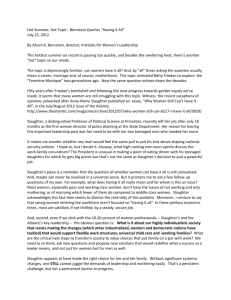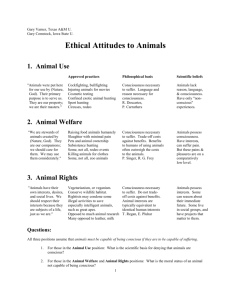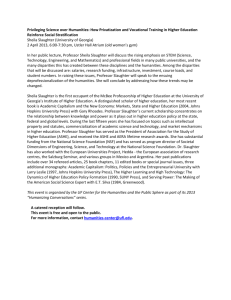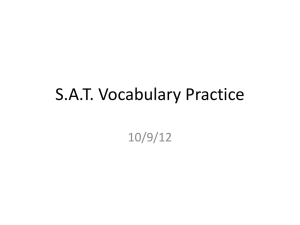An Econometric Decomposition of Aggregate Data:
advertisement
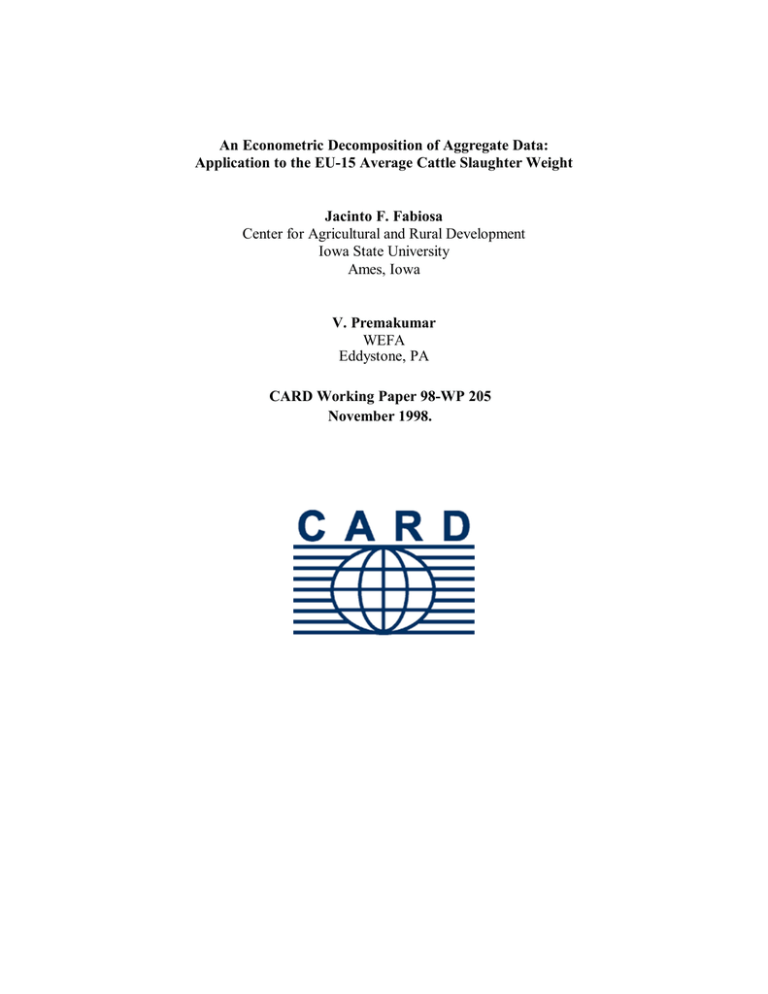
An Econometric Decomposition of Aggregate Data: Application to the EU-15 Average Cattle Slaughter Weight Jacinto F. Fabiosa Center for Agricultural and Rural Development Iowa State University Ames, Iowa V. Premakumar WEFA Eddystone, PA CARD Working Paper 98-WP 205 November 1998. ABSTRACT The level of aggregation of reported data has limited the proper accounting of live animals in most, if not all, livestock models, making the consistency of their underlying biologics suspect. We develop an econometric methodology to decompose a wide range of aggregate data. This method is applied to estimate a disaggregated average cattle slaughter weight for calves, cows, and other cattle from total beef production data in the European Union. The estimated model gave acceptable statistical properties and estimated slaughter weights that closely correspond to reported sample-based slaughter weights across all cattle categories. The model has a good fit, no serial correlation, and highly significant coefficients with consistent signs. Standard validation statistics suggest that the model is able to track well both the mean and variability of the actual average cattle slaughter weight. Furthermore, other decompositions using the same methodology were successful in other countries–New Zealand, and Mexico; other sectors–sheep; and other aggregate data–dairy and beef calving rates. AN ECONOMETRIC DECOMPOSITION OF AGGREGATE DATA: APPLICATION TO THE EU-15 AVERAGE CATTLE SLAUGHTER WEIGHT Most, if not all, models used in generating long-term projections of the world livestock sector do not have a complete and proper accounting of the stock and flow of live animals that ensure consistency in the underlying biologics of the model. Ideally, only the flow of live animals from either a technical relationship (e.g., death and calf crop) or decision of producers (e.g., slaughter number, slaughter weight, and breeding herd addition) should have a behavioral functional specification in a model, and the live animal stock should only be derived through an accounting identity. The EU-15 CPPA model (USDA) includes only the meat side with no specification of any live animal inventory number. The EU-15 AgLink model (OECD), on the other hand, includes a specification of live animal inventory number as a behavioral equation, but accounting of live animal flow such as calf-crop, slaughter, and death is absent. The EU15 FAPRI model (FAPRI, 1997) comes close to including specifications for live animal inventory and live animal number flow. The primary reason for the absence of a clear accounting of live animal stocks and live animal flows in many models is dictated by what data are available. In the case of livestock data, both USDA’s PS&D and OECD’s database report aggregated variables that do not easily detail the number of live animals. This is glaringly true for cattle. For example, cattle death is reported as a total number with no breakdown of death by animal category. Also, although the cow inventory is divided into dairy and beef cows, the calves born is not similarly disaggregated. In some cases, the number of cattle slaughtered is not divided into categories such as, cow, calf, or other cattle. Moreover, it is not easy to derive a meaningful average cattle slaughter weight from aggregate production data. There are a number of compelling reasons why proper accounting of live animal stock and live animal flow is necessary in modeling the livestock sector. First and, this is 2 / Premakumar and Fabiosa the only way that the underlying biologics in the model can be consistent. Also there are technical and policy impacts specific to particular animal categories that can only be captured when the specification allows a disaggregated accounting of live animal stocks and flows. Good examples are the recent foot-and-mouth disease (FMD) outbreak in Taiwan and the classical swine fever (CSF) outbreak in the European Union (EU). These outbreaks may have differential impacts on piglets, sows, and other swine. If such detail of differential impact is reported, as in the CSF in the EU-15, then it is easy to incorporate that impact in a model where live animal stocks and live animal flows are properly accounted. Although our econometric decomposition is general enough to be useful in other types of aggregate data decomposition, the focus of our application is the derivation of average cattle slaughter weight by animal category (i.e., calf, cow, and other cattle) from aggregate production data. Derivation of average cattle slaughter weight by simply dividing total beef production with total number of cattle slaughtered is not very meaningful for behavioral specification. When beef production comes from three different animal categories with different average weights, then an aggregate slaughter weight is not only a function of beef-feed price ratio and technology but also the relative proportions of the categories of animals slaughtered. That is, holding all else constant, average slaughter weight will decline if more calves are slaughtered relative to cows and other cattle. If there are technical and policy impacts that change this mix of categories of animals slaughtered, then a simple average slaughter weight equation is suspect. In this case, it is necessary to derive a representation of the average slaughter weight by category of animal. Although not available from reported data, the methodology developed here derives them from the reported aggregate production and slaughter number data. This method is applied in the EU-15 because there are policy measures in its beefcattle sector that give a classic example of a policy-induced need for a derivation of average cattle slaughter weight by animal category for a detailed accounting of live animal stock and flows. In response to the 1996 Bovine Spongiform Encephalopathy (BSE), An Econometric Decomposition of Aggregate Data / 3 policies were introduced to reduce beef supply in the market as a strategy to support prices. These policies have animal category specific intended impacts.1 For example, two specific policies were targeted to reduce availability of calves for beef production as well as reduce slaughter weight. The first is the calf-processing scheme that provides a premium of 120 European currency units (ECUs) for 20-day old male dairy calves and 150 ECUs for beef calves. The second is the early marketing premium scheme, which awards a basic premium of 50 ECUs for veal calves slaughtered at a weight 15 percent below the 1995 national average. These schemes are expected to reduce beef and veal production by 200,000 metric tons per year. With these schemes, the number of calves slaughtered may increase, causing the average slaughter weight to decline. Without a slaughter weight specification that is disaggregated into calves, cows, and other cattle, the impacts of these policies cannot be captured accurately in the model. Model The proposed econometric decomposition exploits the fact that even if the data are highly aggregated and if the variability in the final explanatory variables still allows identification of the parameters uniquely associated with each of its underlying components, then an econometric decomposition is possible. Although the same approach can be applied to similar aggregate data such as cattle death and calf-crop, the application developed here is on the average cattle slaughter weight by category of cattle. If total beef production is given and there are three categories of cattle slaughtered – calf, cows, and other cattle – deriving an average slaughter weight for each animal type is difficult, but not impossible. The following econometric decomposition can be applied. Consider the identity, where total beef production is equal to the sum of its underlying components including production from calves, cows, and other cattle, i.e., BVSPRt = CCKWVt .CCKCVt + CCKWBt .CCKBRt + CCKWCt .CCKCOt , 1 (1) An Over 30 Months Scheme (OTMS) is a compensation scheme that removes cattle aged more than 30 4 / Premakumar and Fabiosa where BVSPR is total beef production, CCKWV , CCKWB, and CCKWC is the average slaughter weight for calves, cows (i.e., breeding herd), and other cattle, respectively. The number slaughtered for each animal category is CCKCV, CCKBR, and CCKCO. Although slaughter weight data are not available, we represent the unreported average slaughter weight for calves slaughtered as, [2] PB CCKWVt = α 0 + α 1 t + α 2T + ε 1t , PFt where PB is the price of beef, PF is the price of feed, T is a trend to capture technology, ε is an independently, and identically distributed (iid) error process, and α is a vector of parameters.2 A similar specification can be given for the unreported slaughter weight for cows and other cattle slaughtered. Substituting the respective slaughter weight equations in [1] we get [3] PB BVSPRt = (α 0 + α 1 t PFt PB ( β 0 + β1 t PFt + α 2T + ε 1t ).CCKCVt + PB + β 2T + ε 2t ).CCKBRt + (δ 0 + δ 1 t PFt + δ 2T + ε 3t ).CCKCOt Although the parameters of the unobserved slaughter weight equations (i.e., the vector of parameters α, β, and δ) can be estimated using only reported data (i.e., production and slaughter number) from equation [3], the properties of the parameter estimates are suspect because of the error structure in [3]. Diving both sides by the total number of cattle slaughtered (CCKTN=CCKV+CCKBR+CCKO), months of age from the human and animal food chain in the UK. 2 A vector of other regressors can be included in [2]. An Econometric Decomposition of Aggregate Data / 5 [4] PB CCKWt = (α 0 + α 1 t PFt PB ( β 0 + β1 t PFt + α 2T + ε 1t ). KCVSt + PB + β 2T + ε 2t ).KBRS t + (δ 0 + δ 1 t PFt + δ 2T + ε 3t ). KCOSt + ε t , where CCKW is the average slaughter weight, KCVS, KBRS, and KCOS, are the share of calf, cow, and other cattle slaughtered in the total slaughter. Equation [4] expresses average slaughter weight as a function of beef-feed price ratio, technology, and the mix of cattle slaughtered with the parameters of the cattle slaughter weight by cattle category. Equation [4] has no intercept and has an error structure of [5] ε t = ε 1t .KCVSt + ε 2 t .KBRS t + ε 3t .KCOSt . With an additional assumption that the error processes across the average weight equation for each category of animal are identical, equation [4] is further reformulated to derive a good estimating equation. Imposing this assumption and re-arranging terms, [6] CCKW t = α 0 + ( β 0 − α 0 ). KBRS t + (δ 0 − α 0 ). KCOS t + α1 . PB PBt PB + ( β1 − α1 ). t .KBRSt + (δ 1 − α1 ). t .KCOSt + PFt PFt PFt α 2 .T + ( β 2 − α 2 ).T .KBRS t + (δ 2 − α 2 ).T .KCOSt + ε t’ . Equation [6] has several acceptable properties. First, it can be estimated as a linear equation. The multiplicative explanatory variables can be defined as a new variable (i.e., PB1t PBt = .KBRSt ) and the coefficients can be estimated as an aggregate with the PF1t PFt individual coefficients derived after estimation (i.e., γ 1 = ( β1 − α1 ) and then β1 = (γ 1 + α1 ) .3 Of more importance, however, the error term is well-behaved, ensuring unbiased and consistent estimates. That is, if ε 1t = ε 2 t = ε 3t , then ε t = ε 1t .KCVS t + ε 2t .KBRS t + ε 3t .KCOSt = ε t’ = ε it for i=1,2,3. 3 The coefficients can also be estimated directly using a nonlinear estimator. 6 / Premakumar and Fabiosa The approach outlined in this section can be applied to decompose other highly aggregated data. Data and Results Meat production and live animal inventory were taken from USDA’s PS&D database, while prices were taken from OECD’s database. In the case of the EU-15, although a longer series was available, estimation used only the period from 1980 to 1994. In 1995, Austria, Finland, and Sweden joined the EU. Their data cannot be included easily because the EU-12 cattle sector was heavily influenced by the milk quota policy, where producers were penalized with a super-levy for producing above the quota, which was not binding to these new members. Mean values of some key variables are given in Table 1. The average slaughter weight was 265.80 kilograms per head carcass weight. The slaughter rates (number slaughtered relative to animal inventory) for each animal category are very close, 23.57 percent for calves, 25.63 percent for cows, and 28.51 percent for other cattle. Slaughter of other cattle account for close to half of total slaughter at 47.69 percent, followed by cow slaughter share at 28.51 percent, and calf slaughter share at 23.80 percent. The average slaughter weight model has very acceptable statistical properties. Table 2 shows that the model has a good fit, with an R2 at 0.974 and adjusted R2 at 0.964. Although the DW-statistic of 1.593 is in the inconclusive range, with a critical value at 1 percent significance level at dl=0.488 and du=1.704, the DW-statistic is more towards the upper limit that would accept the hypothesis of no serial correlation. Except for the coefficient associated with calf weight, all the parameters are highly significant. Of more importance, the signs of the coefficients are also consistent with expectations; that is, beef price has a positive impact on the slaughter weight (elasticity of 0.0653), while otherwise for feed price. Moreover, the methodology successfully derived and estimated slaughter weights for calves, cows, and other cattle from total beef production data. To validate the An Econometric Decomposition of Aggregate Data / 7 methodology, Table 3 compares the estimated average slaughter weight by animal category with some reported weights from sample information. Several countries report maximum slaughter weight for calves in the EU’s early marketing premium scheme. The average for France, Germany, and Italy of 109 kilograms per head is very close to the estimated average slaughter weight for calves of 108. 4 The reported slaughter weight for cows and other cattle is taken from the Cattle Grading Scheme of some EU members. For cow slaughter weight, the average for Belgium, Denmark, Germany, and Italy is 228 kilograms per head, which is very close to the estimated average cow slaughter weight of 233 kilograms per head. There is more variability of slaughter weight in the other cattle category. The range for Germany is 319 to 432, or an average of 376 kilograms per head, which is close to the estimated average of 370 kilograms per head. Standard validation statistics of the average cattle slaughter weight model are given in Table 3. Both the mean and standard deviation of the actual and predicted series are very close. This good fit is similarly shown in the low percent mean error, 0.004 percent. The correlation of the actual and predicted series is very high at 0.987. The decomposition of the MSE suggests that almost all of the prediction error is due to random process and none of it is due to bias or other structural error. Moreover, the model is able to track well not only the mean of cattle slaughter weight but also its variability. Theil statistics approach zero, suggesting a very good fit. Further validations were performed with the decomposition of other aggregrate data. A disaggregated average cattle slaughter weight was estimated for New Zealand and Mexico. Beef production in both countries are grass-fed in their cattle production system. The estimated average weights shown in Table 1 are very reasonable. For example, an attaché report gives the export beef slaughter weight New Zealand in 1996 at 253 kilograms per head, which is very close to the estimated average slaughter weight for other cattle in New Zealand at 255 kilograms per head (USDA, AGR #NZ7006). 4 France, Germany, and Italy represent 52 percent of total EU cattle inventory. 8 / Premakumar and Fabiosa Moreover, the same approach was applied in other animals—in New Zealand’s sheep sector, and in the EU’s dairy and beef calf-crop—with similar success.5 Conclusion The general issue addressed in this paper concerns the lack of proper and complete accounting of live animal stock and flow in most, if not all, livestock models used in generating long-term projections for the world. The common problem is the high level of aggregation in available data that do not lend easily to detailed accounting. An econometric methodology was developed to decompose aggregate data and was applied to derive and estimate a behavioral specification of average cattle slaughter weight by cattle category in the EU cattle sector. The model gave acceptable statistical properties: good fit, no serial correlation, highly significant coefficients, consistent signs of coefficients that give estimated average slaughter weight close to reported slaughter weight across all cattle categories. Standard validation statistics suggest that the model is able to track well both the mean and variability of actual slaughter weight series. Furthermore, other validations were successfully applied to New Zealand and Mexico, to New Zealand’s sheep sector, and to other aggregate data for EU’s dairy and beef calving rates. 5 Full results of additional validations can be obtained from the authors. An Econometric Decomposition of Aggregate Data / 9 Table 1. Means of variables and elasticity Variables Mean of Variables Slaughter Weight (kg/head carcass) Calf Slaughter Rate (%) Cow Slaughter Rate (%) Other Cattle Slaughter Rate (%) Proportion of Calves Slaughtered (%) Proportion of Cows Slaughtered (%) Proportion of Other Cattle Slaughtered (%) 265.80 23.57 25.63 28.51 23.80 28.51 47.69 Elasticity of Slaughter Weight to Price 0.0653 Mean Table 2. Average slaughter weight for cattle in the EU-15, New Zealand, and Mexico EU-15 N. Zealand Mexico Parameter Independent Coef S. Dev Coef S. Dev Coef S. Dev Calf Weight 0.108 0.088 0.0764 0.0301 0.0750 α0 Cow Weight 0.233 0.048 0.1679 0.0808 0.1479 0.0568 β0 Intercept 0.245 0.021 0.1718 0.0869 0.1219 0.0718 δ0 Trend 0.004 0.001 0.0024 0.0017 0.0039 0.0014 δ1 Price Ratio 0.018 0.008 0.0001 0.0001 0.0001 0.0001 δ2 Diagnostic R2 0.974 0.832 0.794 Adj R2 0.964 0.756 0.701 DW 1.593 1.591 1.115 Table 3. Estimated and reported slaughter weights (from sample information) Model Estimate Reports Average Calf Slaughter Weight 108 109 France (52%) 108 Germany 103 Italy 117 Average Cow Slaughter Weight 233 228 Belgium 255 Denmark 200 Germany 240 Italy 216 Average Other Cattle Slaughter Weight 370 376 Germany 319 - 432 10 / Premakumar and Fabiosa Table 4. Cattle average slaughter weight model validation Actual Mean Std Dev Slaughter Weight 0.2556 0.0114 Statistics of Fit Mean Error Percent Mean Error Mean Absolute Error Mean Absolute Percent Error Root Mean Square Error Root Mean Square Percent Error R-square Theil Forecast Error Statistics Mean Square Error Correlation Bias Regression Disturbance Variance Co-variance Theil U1 Theil U Predicted Mean Std Dev 0.2556 0.0113 0.0000 0.0044 0.0015 0.5682 0.0018 0.6900 0.9742 3.1E-06 0.9870 0.0000 0.0000 1.0000 0.0070 0.9930 0.0069 0.0035 REFERENCES Food and Agricultural Policy Research Institute (FAPRI). FAPRI Integrated Livestock and Poultry Model. 1997. Meat and Livestock Council. European Handbook: The Common Agricultural Policy. Volume I. Paris, France, 1997. OECD. Agriculture Database, (electronic-disk), 1997, Paris, France. SAS Institute Inc., SAS/ETS User’s Guide, Version 6, Second Edition, Cary, NC: SAS Institute Inc., 1993. U.S. Department of Agriculture, Economic Research Service. PS&D Database, (electronic), June 23, 1997. <http://mann77.mannlib.cornell.edu/data-sets/international/93002/> U.S. Department of Agriculture. Foreign Agriculture Service (FAS). New Zealand Livestock Semi-Annual Report, AGR Number NZ7006. 1997. Filename: WP_JAY2.doc Directory: C:\My documents\Downloaded Papers Template: C:\Program Files\Microsoft Office\Templates\Normal.dot Title: An Econometric Decomposition of Aggregate Data: Subject: Author: Valued Gateway Customer Keywords: Comments: Creation Date: 10/20/98 10:36 AM Change Number: 3 Last Saved On: 12/09/98 11:46 AM Last Saved By: Valued Gateway Customer Total Editing Time: 31 Minutes Last Printed On: 03/18/99 2:10 PM As of Last Complete Printing Number of Pages: 13 Number of Words: 2,684 (approx.) Number of Characters: 15,304 (approx.)
